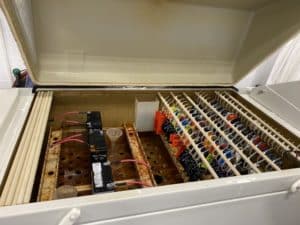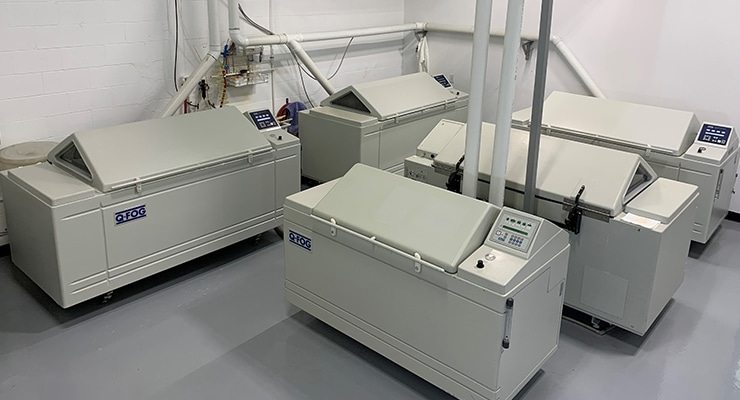ASTM B117
Salt Spray Fog Testing
ASTM B117 is a salt spray test used to produce relative corrosion resistance information for specimens of metals and coated metals exposed in a standardized corrosive environment. Micom offers ASTM B117 accelerated corrosion testing as part of its surface finish and accelerated aging testing services.
ASTM B117 Uses and Factors to Consider
According to ASTM International, ASTM B117, in and of itself, is not a test specification. Rather, it outlines the standard practice for operating salt spray (fog) apparatus. ASTM B117 is a document establishing the parameters and requirements for operating a salt spray test chamber. It specifies how to create and maintain the salt fog test environment so that results can be achieved consistently from lab to lab and chamber to chamber.
ASTM B117 does not specify anything about the type of test specimen, dimensions, shape or exposure periods to be used for a specific product, nor does it have any requirements or guidance for the interpretation of the results.
ASTM B117 is used in many industries, including:
- Automotive (example: SAE J14563, GM 4298P…)
- Paints and Coatings
- Aerospace
- Military (MIL-STD-810)
Among others, the following test methods call up practice ASTM B117:
| ASTM D1654 | M0140 (Nissan) |
| ASTM D1735 | SAE 1455 |
| ASTM D2247 | GM 4298P (General Motors) |
| ASTM D5894 | GM 9540 (General Motors) |
| ASTM G44 | TSH1552G (Toyota) |
| ASTM G85 | HES 6501 (Honda) |
| ISO 9227 | SAE USCAR – 24 |
| MIL – STD – 810 meth. 509.4 | |
| MIL – STD – 331B |
This practice is used in many other standards, both in North America and across the world. For a list of salt spray tests please see: salt spray methods list.
The type and number of test specimens to be used, as well as the criteria for the evaluation of the test results, will be required in the specifications covering the product being exposed or shall be mutually agreed upon by the parties involved.
We take care of testing from start to finish
So you can focus on what you do best
We get it, we're the only ones in the room excited by testing.
That's why we've fine-tuned every step of the testing process to provide you with
a fast and reliable service at a cost that will keep you coming back.
This is the Micom promise.
We take care of testing from start to finish
So you can focus on what you do best
We get it, we're the only ones in the room excited by testing.
That's why we've fine-tuned every step of the testing process to provide you with
a fast and reliable service at a cost that will keep you coming back.
This is the Micom promise.
We take care of testing from start to finish
So you can focus on what you do best
We get it, we're the only ones in the room excited by testing.
That's why we've fine-tuned every step of the testing process to provide you with
a fast and reliable service at a cost that will keep you coming back.
This is the Micom promise.
Why do I need the ASTM B117 test and what will the results show?
There are many different reasons for which you should conduct salt fog testing, chief among them is determining the effect of corrosion on your specimen. Different metals and surfaces can exhibit differing amounts of resistance with respect to corrosion, and ASTM B117 testing will allow you to compare this. It will also allow you to judge a surface’s tendency to corrode when it is scratched as well as the adhesion of its coating.
The results you gain from salt spray testing will allow you to gauge how well your metal, surface or coating can resist corrosion. By combining ASTM B117 with some of the other tests mentioned above, like ASTM D1654 and ASTM D3359, you can also see how much scratching will affect the corrosion of your specimen and how far corrosion creeps.
Typical Experimental Parameters for the ASTM B117 Test
There are numerous parameters we will want to confirm with you in order to run a proper ASTM B117 salt spray test. These include:
- Number of specimens/products: usually 1 (to be confirmed)
- Specimen dimensions: 3” X 6” (Typical for flat specimen. 3D samples can also be tested. Please specify dimensions)
- Exposure duration: hours
- Optional sample preparation to be specified:
- Cleaning
- Scribing (ASTM D1654 or other)
- Edges protection if exposed
- Orientation (if required please specify): While in the salt spray cabinet, specimens shall be supported or suspended between 15 and 30 degrees from perfectly vertical and, preferably, parallel to the principal direction of flow of fog through the chamber, based upon the dominant surface being tested. Samples shall be supported by their bottom or side.
- Visual inspection (if specified please specify time intervals)
- Post-test evaluations:
- You may require interval/post-test evaluations for your sample(s).
Most Requested Test Methods
- ASTM D610: Rusting on painted metal
- ASTM D714: Blistering on painted metal
- ASTM D1654: Rust creepage (final inspection)
- ASTM D3359: Tape Adhesion
- ASTM D3363: Coating Hardness
- And many others…
Corrosion Testing Equipment
Other Related Test Methods
As mentioned above, ASTM B117 is a specific accelerated aging test. For other aging tests and additional test methods related to ASTM B117, please see UV testing, Climatic chamber testing, Coating testing.
ASTM B117 Salt Spray Fog Test Document Download
We invite you to download your own copy of the ASTM B117 document below.
The Appendix below provides additional information about numerous material tests carried out at Micom Laboratories including classification of corrosion test results according to ASTM D610 .
We also invite you to download our brochure to learn more about our Paint, Coating and Polymer testing services.
ASTM B117 Testing – Common Questions
1. Why do I need to run an ASTM B117 test?
ASTM B117 is a salt spray test used to produce relative corrosion resistance information for specimens of metals and coated metals exposed in a standardized corrosive environment. It is recognized internationally and widely used in the following industries: automotive, paints and coatings, aerospace, and military (as part of the MIL-STD-810 standard).
2. What information will I need to provide to the laboratory?
Before Micom Laboratories sets up your customized test, we will need to know how many test specimens (usually 1) per product/material you wish to test, specimen dimensions, exposure duration hours, sample preparation and cleaning requirements, sample orientation, visual inspection, time intervals, and post-test evaluations. When you contact us, we will further guide you through this process.
3. What size sample should I use?
Sample size varies a lot and depends on the application. It can go from tiny screws to large sub-assemblies e.g a truck radiator with supporting brackets. You want to make sure you are testing a life-representative sample.
4. What results can I expect from an ASTM B117 test?
The results you gain from salt spray testing will allow you to gauge how well your metal, surface or coating can resist corrosion. Different metals and surfaces can exhibit differing amounts of resistance with respect to corrosion, and ASTM B117 testing will allow you to compare this. It will also allow you to judge a surface’s tendency to corrode when it is scratched (if your samples are scribed ASTM D1654) as well as the adhesion of its coating.
5. How long an exposure should I use?
The exposure time varies considerably as a function of your product application. There is no way to predict that “X” many hours in a salt spray test will simulate exactly “X” years in the field, as this test does not represent any specific real -life scenario. However the longer your sample can stay in the cabinet without showing degradation signs, the more corrosion resistant it will be. As a reference, decorative parts such as the ones found in bathrooms will often get tested for an exposure between 24 and 96 hours. Structural galvanized components used outdoors will often get an exposure of 8000-10,000 hours.
6. What secondary or follow-up tests are recommended with an ASTM B117 test?
ASTM D610 is often used to assess the rate of corrosion for steel painted samples. it is also complemented by ASTM D714 which will quantify the blistering degree of paint steel samples
ASTM D3359 is a tape adhesion test is often used to evaluate coating adhesion following the ASTM B117 salt spray fog test. Micom Laboratories offers ASTM D3359 test as part of its Coating test services. The ASTM D1654 is used as a final inspection test to determine the extent of rust creepage on your specimens.
7. Is ASTM B117 the only corrosion test available?
ASTM B117 was the first recognized test method worldwide and was published in 1939. More sophisticated techniques have been developed since then, namely the ASTM G85 – Standard Practice for Modified Salt Spray testing. This practice is actually comprised of 5 different corrosive atmospheres:
- Acetic Acid Salt spray Test (often used on decorative chromium plating on steel)
- Cyclic Acidified Salt Fog Test (exfoliation testing of some aluminum alloys)
- Acidified Synthetic Sea Water Fog Test (often used to test Aluminum alloys)
- Salt/SO2 Spray Test (exfoliation corrosion/inter granular attack)
- Dilute Electrolyte Cyclic Fog Test (Industrial Protective Coatings Evaluations)
ASTM D5894 combines the salt spray exposure with sun aging.
SAE J2334 is somewhat similar to ASTM G-85 cycle but with a different electrolyte solution
GM 9540 cyclic corrosion testing, somewhat similar to SAE J2334
Contact Us For Your ASTM B117 Test Requirements
If you have any questions about the ASTM B117 test, we invite you to contact our material testing lab today. It will be our pleasure to answer your questions and help you with your custom material testing requirements.



